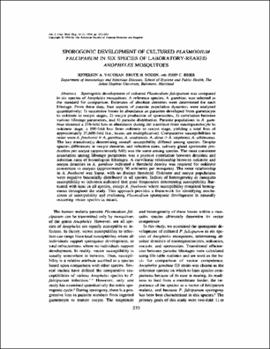| dc.contributor.author | Vaughan, Jefferson A. | |
| dc.contributor.author | Noden, Bruce H. | |
| dc.contributor.author | Beier, John C. | |
| dc.date.accessioned | 2022-04-12T13:29:50Z | |
| dc.date.available | 2022-04-12T13:29:50Z | |
| dc.date.issued | 1994 | |
| dc.identifier | oksd_noden_sporogonicdevelopment_1994 | |
| dc.identifier.citation | Vaughan, J. A., Noden, B. H., & Beier, J. C. (1994). Sporogonic development of cultured Plasmodium falciparum in six species of laboratory-reared Anopheles mosquitoes. American Journal of Tropical Medicine and Hygiene, 51(2), pp. 233-243. https://doi.org/10.4269/ajtmh.1994.51.233 | |
| dc.identifier.uri | https://hdl.handle.net/11244/335135 | |
| dc.description.abstract | Sporogonic development of cultured Plasmodium falciparum was compared in six species of Anopheles mosquitoes. A reference species, A. gambiae, was selected as the standard for comparison. Estimates of absolute densities were determined for each lifestage. From these data, four aspects of parasite population dynamics were analyzed quantitatively: 1) successive losses in abundance as parasites developed from gametocyte to ookinete to oocyst stages, 2) oocyst production of sporozoites, 3) correlation between various lifestage parameters, and 4) parasite distribution. Parasite populations in A. gambiae incurred a 316-fold loss in abundance during the transition from macrogametocyte to ookinete stage, a 100-fold loss from ookinete to oocyst stage, yielding a total loss of approximately 31,600-fold (i.e., losses are multiplicative). Comparative susceptibilities in order were A. freeborni >> A. gambiae, A. arabiensis, A. dirus > A. stephensi, A. albimanus. The key transition(s) determining overall susceptibility differed among species. Despite species differences in oocyst densities and infection rates, salivary gland sporozoite production per oocyst (approximately 640) was the same among species. The most consistent association among lifestage parameters was a positive correlation between densities and infection rates of homologous lifestages. A curvilinear relationship between ookinete and oocyst densities in A. gambiae indicated a threshold density was required for ookinete conversion to oocysts (approximately 30 ookinetes per mosquito). The same relationship in A. freeborni was linear, with no distinct threshold. Ookinete and oocyst populations were negative binomially distributed in all species. Indices of heterogeneity in mosquito susceptibility to infection indicated that gene frequencies determining susceptibility fluctuated with time in all species, except A. freeborni where susceptibility remained homogenous throughout the study. This approach provides a framework for identifying mechanisms of susceptibility and evaluating Plasmodium sporogonic development in naturally occurring vector species in nature. | |
| dc.format | application/pdf | |
| dc.language | en_US | |
| dc.publisher | American Society of Tropical Medicine and Hygiene | |
| dc.relation.ispartof | American Journal of Tropical Medicine and Hygiene, 51 (2) | |
| dc.relation.uri | https://www.ncbi.nlm.nih.gov/pubmed/8074258 | |
| dc.rights | This material has been previously published. In the Oklahoma State University Library's institutional repository this version is made available through the open access principles and the terms of agreement/consent between the author(s) and the publisher. The permission policy on the use, reproduction or distribution of the material falls under fair use for educational, scholarship, and research purposes. Contact Digital Resources and Discovery Services at lib-dls@okstate.edu or 405-744-9161 for further information. | |
| dc.subject.mesh | Analysis of Variance | |
| dc.subject.mesh | Animals | |
| dc.subject.mesh | Anopheles | |
| dc.subject.mesh | Erythrocytes | |
| dc.subject.mesh | Feeding Behavior | |
| dc.subject.mesh | Insect Vectors | |
| dc.subject.mesh | Plasmodium falciparum | |
| dc.subject.mesh | Species Specificity | |
| dc.title | Sporogonic development of cultured Plasmodium falciparum in six species of laboratory-reared Anopheles mosquitoes | |
| dc.date.updated | 2022-04-07T14:57:24Z | |
| osu.filename | oksd_noden_sporogonicdevelopment_1994.pdf | |
| dc.description.peerreview | Peer reviewed | |
| dc.identifier.doi | 10.4269/ajtmh.1994.51.233 | |
| dc.description.department | Entomology and Plant Pathology | |
| dc.type.genre | Article | |
| dc.type.material | Text | |
| dc.subject.keywords | Malaria | |
| dc.subject.keywords | Rare Diseases | |
| dc.subject.keywords | Vector-Borne Diseases | |
| dc.subject.keywords | Infectious Diseases | |
| dc.subject.keywords | 2.2 Factors relating to the physical environment | |
| dc.subject.keywords | Infection | |
| dc.subject.keywords | 11 Medical and Health Sciences | |
| dc.subject.keywords | Tropical Medicine | |
| dc.identifier.author | ScopusID: 7202772214 (Vaughan, JA) | |
| dc.identifier.author | ORCID: 0000-0002-0096-370X (Noden, BH) | |
| dc.identifier.author | ScopusID: 6601968347 (Noden, BH) | |
| dc.identifier.author | ScopusID: 7102003162 (Beier, JC) | |
